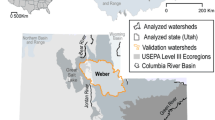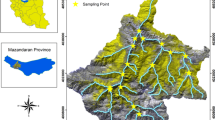Abstract
A spatially explicit linear, additive model was developed for quantifying site characteristics of riparian areas of the lower Cedar River, Washington, USA. The spatial complexity and distribution of combined habitat and anthropogenic landscape features were used to define habitat “indices” that indicate the relative quality of riparian habitats. Patches of contiguous grid cells were measured in terms of their locations, sizes, and relative degree of fragmentation. Additionally, intrapatch heterogeneity was measured to identify unique combinations of habitat and anthropogenic factors for individual grid cells within patches. Model verification indicated that existing floodplain riparian habitats received positive indices more than 90% of the time. Mean patch sizes and fragmentation indices were similar for all positive indices throughout the reaches in the valley floor. Among all reaches, reach 7 had the highest number of positive patches due to a higher degree of meandering in this reach. This procedure and model outputs provide unique screening opportunities for prioritizing management of riparian areas (e.g., conservation, restoration and enhancement).



Similar content being viewed by others
References
P. A. Bisson R. E. Bilby M. D. Bryant C. A. Dollof G. B. Grette R. A. House M. L. Murphy K.V. Koski J.R. Sedell (1987) Large woody debris in forested streams in the Pacific Northwest: past, present, and future.In E. O. Salo T. W. Cundy (Eds) Streamside Management: Forestry and Fishery Interactions. University of Washington, Institute of Forest Resources Seattle Pages 143–190
Booth, D. B. (1984) Glacier dynamics and the development of glacial landforms in the eastern Puget lowland, Washington. PhD dissertation. Geological Sciences, University of Washington, Seattle, WA, 217 pp
B. D. Collins G.R. Pess (1997) ArticleTitleCritique of Washington’s watershed analysis program. Journal of The American Water Resources Association 33 997–1010
M. Denysius C. Nilsson (1994) ArticleTitleFragmentation and flow regulation of river systems in the northern third of the world. Science 266 753–762 Occurrence Handle1:CAS:528:DyaK2MXitVGgsL8%3D
ESRI, (Environmental Systems Research Institute). 1999. ArcView GIS 3.2. Copyright 1992–1999. Environmental Systems Research Institute, Redlands. California.
ESRI (Environmental Systems Research Institute). 2001. GRID 8.1. Copyright 1982–2001. Environmental Systems Research Institute Redlands, California.
R. T. T. Forman M. Godron (1986) Landscape ecology. John Wiley & Sons New York 619 pp
C. A. Frissell W. J. Liss C. E. Warren M. D. Hurley (1986) ArticleTitleA hierarchical framework for stream habitat classification: viewing streams in a watershed context. Environmental Management 10 199–214
D. L. Galat L. H. Fredrickson D. D. Humburg K. L. Bataille (1998) ArticleTitleFlooding to restore connectivity of regulated, large-river wetlands. BioScience 48 721–733
J. A. Gore F.D. Shields Jr (1995) ArticleTitleCan large rivers be restored? BioScience 45 142–152
J. S. Hanson G. P. Malanson M. P. Armstrong (1990) ArticleTitleLandscape fragmentation and dispersal in a model of riparian forest dynamics. Ecological Modeling 49 277–296 Occurrence Handle10.1016/0304-3800(90)90031-B
R. Harris C. Olson (1997) ArticleTitleTwo-stage system for prioritizing riparian restoration at the stream reach and community scales. Restoration Ecology 5(48) 34–42
M. E. Kentula (1997) ArticleTitleA step toward a landscape approach in riparian restoration. Restoration Ecology 5 2–3
King County. 1993. Cedar River current and future conditions report. King County Department of Public Works, Surface Water Management Division, Seattle, 322 pp.
King County. 1998. Lower Cedar River Basin and nonpoint pollution action plan. King County Department of Natural Resources, Seattle, 352 pp.
G. H. Kondolf (1995) ArticleTitleGeomorphological stream channel classification in aquatic habitat restoration: uses and limitations. Aquatic conservation. Marine and Freshwater Ecosystems 5 127–141
T. M. Lillesand R. W. Kiefer (1994) Remote sensing and image interpretation John Wiley & Sons New York 750 pp
C. W. May R. R. Horner (2000) The cumulative impacts of watershed urbanization on stream-rlparian ecosystems.In P. J. Wigington R. L. Beschta (Eds) International conference on riparian ecology and management in multi-land use watersheds American Water Resources Association Middlesburg, Virginia Pages 281–286
McGarigal, K. and Marks. B. J. 1995. FRAGSTATS: spatial pattern analysis program for quantifying landscape structure. USDA Forest Service, Portland, Oregon, 122 pp.
H. T. Mowrer (1999) Accuracy (re)assurance: selling uncertainty assessment to the uncertain in K. Lawton A. Jaton (Eds) Spatial accuracy assessment: land information uncertainty in natural resources Ann Arbor Press Chelsea, Michigan pages 1–10
M. L. Murphy J. Heifetz S. W. Johnson K. V. Koski J. F. Thedinga (1986) ArticleTitleEffects of clear-cut logging with and without buffer strips on juvenile salmonids in Alaskan streams (USA). Canadian Journal of Fisheries and Aquatic Sciences 43 1521–1533
InstitutionalAuthorNameNRC (National Research Council). (1992) Restoration of aquatic ecosystems National Academy Press Washington, DC
InstitutionalAuthorNameNRC (National Research Council). (1996) Upstream: salmon and society in the Pacific Northwest National Academy Press Washington, DC
S. J. Perkins (1994) ArticleTitleThe shrinking Cedar River: channel changes following flow regulation and bank armoring. Journal of the American Water Resources Association 00 649–659
B. D. Richter H. E. Richter (2000) ArticleTitlePrescribing flood regimes to sustain riparian ecosystems along meandering rivers. Conservation Biology 14 1467–1478 Occurrence Handle10.1046/j.1523-1739.2000.98488.x
G. D. Russell C. P. M. Hawkins P. O’Neill (1997) ArticleTitleThe role of GIS in selecting sites for riparian restoration at the San Luis Rey River, San Diego County, California. Restoration Ecology 5(48) 56–68
J. M. Schaefer M. T. Brown (1992) ArticleTitleDesigning and protecting river corridors for wildlife. Rivers 3 14–26
Tri-County (Tri-County Coalition). 2002. Regulation of near shore and aquatic development: a proposal to help protect salmonid habitat in the Puget Sound region. Report from the Technical Committee. Seattle, Washington.
M. G. Turner R. H. Gardner R. V. O’Neill (2001) Landscape ecology in theory and practice: pattern and process Springer-Verlag New York 401 pp
J. V. Ward J. A. Stanford (1995) ArticleTitleEcological connectivity in alluvial river ecosystems and its disruption by flow regulation. Regulated Rivers: Research and Management 11 105–119
R. C. Wissmar R. L. Beschta (1998) ArticleTitleRestoration and Management of Riparian Ecosystems: a Catchment Perspective. Freshwater Biology 40 571–585 Occurrence Handle10.1046/j.1365-2427.1998.00383.x
R. C. Wissmar P. A. Bisson (2003) Strategies for restoring river ecosystems: sources of variability and uncertainty in natural and management systems American Fisheries Society Bethesda, Maryland
R. C. Wissmar D. C. Pflugh R.K. Timm (2000) Changes in developed land cover (1991–1998): Cedar River, Washington, In P. J. Wigington R. L. Beschta (Eds) Riparian ecology and management in multi-land use watersheds American Water Resources Association Middlesburg, Virginia TPS-00-2, 616 pp
R. C. Wissmar J. H. Braatne R. L. Beschta S. B. Rood (2003) Variability of riparian ecosystems: implications for restoration.in R. C. Wissmar P. A. Bisson (Eds) Strategies for restoring river ecosystems: sources of variability and uncertainty in natural and managed systems American Fisheries Society Bethesda, Maryland Pages 107–127
Acknowledgements
This research was supported by a grant from the United States Environmental Protection Agency, Science To Achieve Results (STAR) program, Washington DC, EPA grant R827149-01-0. In addition, we would like to thank Lauren Alexander and Jeff Kershner for formally reviewing the manuscript and providing many helpful suggestions. Julie Hall, Michele Koehler, Josh Latterell, Deron Lawrence, Miles Logsdon, Laura Rattner, and Kathryn Sobocinski provided additional reviews and important criticisms.
Author information
Authors and Affiliations
Corresponding author
Rights and permissions
About this article
Cite this article
Timm, R., Wissmar, R., Small, J. et al. A Screening Procedure for Prioritizing Riparian Management . Environmental Management 33, 151–161 (2004). https://doi.org/10.1007/s00267-003-2980-z
Published:
Issue Date:
DOI: https://doi.org/10.1007/s00267-003-2980-z




